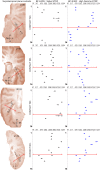Sparse Spectro-Temporal Receptive Fields Based on Multi-Unit and High-Gamma Responses in Human Auditory Cortex
- PMID: 26367010
- PMCID: PMC4569421
- DOI: 10.1371/journal.pone.0137915
Sparse Spectro-Temporal Receptive Fields Based on Multi-Unit and High-Gamma Responses in Human Auditory Cortex
Abstract
Spectro-Temporal Receptive Fields (STRFs) were estimated from both multi-unit sorted clusters and high-gamma power responses in human auditory cortex. Intracranial electrophysiological recordings were used to measure responses to a random chord sequence of Gammatone stimuli. Traditional methods for estimating STRFs from single-unit recordings, such as spike-triggered-averages, tend to be noisy and are less robust to other response signals such as local field potentials. We present an extension to recently advanced methods for estimating STRFs from generalized linear models (GLM). A new variant of regression using regularization that penalizes non-zero coefficients is described, which results in a sparse solution. The frequency-time structure of the STRF tends toward grouping in different areas of frequency-time and we demonstrate that group sparsity-inducing penalties applied to GLM estimates of STRFs reduces the background noise while preserving the complex internal structure. The contribution of local spiking activity to the high-gamma power signal was factored out of the STRF using the GLM method, and this contribution was significant in 85 percent of the cases. Although the GLM methods have been used to estimate STRFs in animals, this study examines the detailed structure directly from auditory cortex in the awake human brain. We used this approach to identify an abrupt change in the best frequency of estimated STRFs along posteromedial-to-anterolateral recording locations along the long axis of Heschl's gyrus. This change correlates well with a proposed transition from core to non-core auditory fields previously identified using the temporal response properties of Heschl's gyrus recordings elicited by click-train stimuli.
Conflict of interest statement
Figures








Similar articles
-
Capturing contextual effects in spectro-temporal receptive fields.Hear Res. 2016 Sep;339:195-210. doi: 10.1016/j.heares.2016.07.012. Epub 2016 Jul 27. Hear Res. 2016. PMID: 27473504
-
Differences between spectro-temporal receptive fields derived from artificial and natural stimuli in the auditory cortex.PLoS One. 2012;7(11):e50539. doi: 10.1371/journal.pone.0050539. Epub 2012 Nov 27. PLoS One. 2012. PMID: 23209771 Free PMC article.
-
A generalized linear model for estimating spectrotemporal receptive fields from responses to natural sounds.PLoS One. 2011 Jan 11;6(1):e16104. doi: 10.1371/journal.pone.0016104. PLoS One. 2011. PMID: 21264310 Free PMC article.
-
Context dependence of spectro-temporal receptive fields with implications for neural coding.Hear Res. 2011 Jan;271(1-2):123-32. doi: 10.1016/j.heares.2010.01.014. Epub 2010 Feb 1. Hear Res. 2011. PMID: 20123121 Review.
-
Active listening: task-dependent plasticity of spectrotemporal receptive fields in primary auditory cortex.Hear Res. 2005 Aug;206(1-2):159-76. doi: 10.1016/j.heares.2005.01.015. Hear Res. 2005. PMID: 16081006 Review.
Cited by
-
Differential responses to spectrally degraded speech within human auditory cortex: An intracranial electrophysiology study.Hear Res. 2019 Jan;371:53-65. doi: 10.1016/j.heares.2018.11.009. Epub 2018 Nov 22. Hear Res. 2019. PMID: 30500619 Free PMC article.
-
Electrocorticographic delineation of human auditory cortical fields based on effects of propofol anesthesia.Neuroimage. 2017 May 15;152:78-93. doi: 10.1016/j.neuroimage.2017.02.061. Epub 2017 Feb 27. Neuroimage. 2017. PMID: 28254512 Free PMC article.
-
Auditory processing in the human cortex: An intracranial electrophysiology perspective.Laryngoscope Investig Otolaryngol. 2017 Apr 12;2(4):147-156. doi: 10.1002/lio2.73. eCollection 2017 Aug. Laryngoscope Investig Otolaryngol. 2017. PMID: 28894834 Free PMC article. Review.
-
Neural coding and perception of auditory motion direction based on interaural time differences.J Neurophysiol. 2019 Oct 1;122(4):1821-1842. doi: 10.1152/jn.00081.2019. Epub 2019 Aug 28. J Neurophysiol. 2019. PMID: 31461376 Free PMC article.
-
High gamma coherence between task-responsive sensory-motor cortical regions in a motor reaction-time task.J Neurophysiol. 2023 Sep 1;130(3):628-639. doi: 10.1152/jn.00172.2023. Epub 2023 Aug 16. J Neurophysiol. 2023. PMID: 37584101 Free PMC article.
References
-
- Clarke S, Morosan P. Architecture, Connectivity, and Transmitter Receptors of Human Auditory Cortex In: Poeppel D, Overath T, Popper AN, Fay RR, editors. The Human Auditory Cortex. Springer Handbook of Auditory Research. 43: Springer; New York; 2012. p. 11–38.
-
- Howard MA, Volkov IO, Noh MD, Granner MA, Mirsky R, Garell PC. Chronic microelectrode investigations of normal human brain physiology using a hybrid depth electrode. Stereotact Funct Neurosurg. 1997;68(1–4 Pt 1):236–42. Epub 1997/01/01. . - PubMed
Publication types
MeSH terms
Grants and funding
LinkOut - more resources
Full Text Sources
Other Literature Sources
Medical

